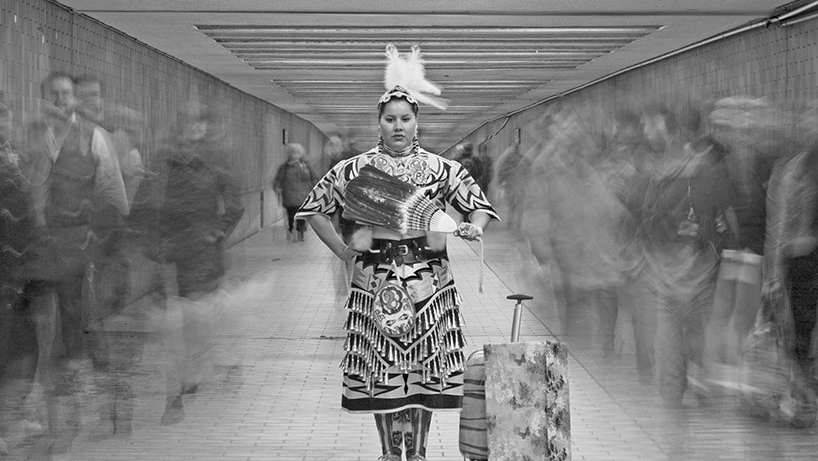By Natalie Michie
On Sept. 1, Ryerson unveiled a new mural that celebrates Indigenous identity and culture.
The mural, displayed at the Ryerson Library entrance, is a photograph by Nadya Kwandibens which features traditional dancer Tee Lyn Duke. Both women are Anishinaabe from Treaty 3 territory.
The image is part of a series by Kwandibens entitled Concrete Indians that showcases Indigenous identities in contemporary, urban settings.
In the photo, taken in 2010, Duke wears a traditional jingle dress and stands in the middle of Spadina Station during rush hour.
“The idea behind [the series] was to provide a way for other Indigenous people living in the city to portray what it feels like and what it looks like to be Indigenous, and how that affects your identity, your sense of belonging [and] where you come from,” said Kwandibens.
Through this series, Kwandibens said she aims to portray visibility for other Indigenous people and in doing so, explores concepts of decolonization.
Tee Lyn Duke, the subject of the photo, is a jingle dancer and regularly rides Toronto transit wearing her traditional regalia, called the jingle dress or the healing dress.
For Duke, there is a personal connection to the jingle dress, as she is from the Treaty 3 territory where it originated. The dress is full of colourful patterns and its lower half is lined with layers of small silver cones, which jingle as dancers move.
“If you’ve ever been around the jingle dress or have seen jingle dress dancers, the sound of the jingle cones can carry, [and] you can hear that sound from [a] really far distance,” said Duke. “I’ve been taught that the sound carries up prayers of healing for those that are sick to the Creator.”
“Even though we’re living in a concrete jungle, we’re here, and we always have been here since time immemorial”
By wearing her regalia in urban spaces like public transit, Duke aims to challenge harmful narratives surrounding Indigenous people in Canada.
“One of the most consistent things that I hear [as] an Indigenous woman living in the GTA is that Indigenous people are not here,” said Duke, referring to the stereotype that you won’t find Indigenous people in urban spaces.
Duke said she wants people to rethink that false narrative; Indigenous populations are growing four times faster than the rest of Canada, meaning young Indigenous people make up the fastest-growing demographic in the country.
“Even though we’re living in a concrete jungle, we’re here, and we always have been here since time immemorial,” Duke said.
This mural comes to Ryerson just a few months after the Egerton Ryerson statue on campus was defaced by protestors, followed by an open letter from hundreds of Ryerson community members asking that the statue be taken down by Ryerson administration.
Egerton Ryerson—the university’s namesake—played a significant role in the creation of Canada’s residential school system which violently removed Indigenous children from their communities in an effort to assimilate them into colonial Euro-Canadian culture.
Earlier this month, university president Mohamed Lachemi made the announcement that a new task force will be created to re-examine the school’s relationship with the historical figure.
“It’s been really fun seeing all of these statues [and] these colonial monuments coming down all over,” said Kwandibens, adding that she wasn’t aware of Egerton Ryerson’s history until recently. “I’m not sure how I feel that that statue is still up.”
As an Indigenous community member, Duke said there’s no easy way to approach conversations surrounding the statue.
“There’s a lot of work that needs to be done, and it’s not going to be done tomorrow, a couple of months from now or a couple of years from now. It’s going to be a long road,” she said.
In 2015, the Truth and Reconciliation Commission of Canada put forward 94 calls to action for all levels of government to work together to change policies and programs that hurt Indigenous communities and to repair the harm caused by residential schools.
“I want to see more Indigenous presence in these institutions; more of these portraits going up, more of everything”
“We have 94 calls to action that we’re supposed to be meeting at every level, and that doesn’t exempt educational institutions [or] spaces that remind us of tragedies [and] traumatic experiences that have happened,” Duke said.
“You really have to think about how these things slow down our connections to truth and reconciliation.”
In pursuing reconciliation, both Duke and Kwandibens said that educational institutions should increase Indigenous representation on campus through work such as the new mural.
“I want to see more Indigenous presence in these institutions; more of these portraits going up, more of everything,” Kwandibens said. “There’s so much work that Indigenous people do in our own daily lives to … share our stories of revitalization, reclamation … [and] just existing as we are today.”
Kwandibens said she hopes this piece reminds people that Canada itself is Indigenous land and Indigenous people have always been here.
“I think it’s really powerful that an Indigenous woman is being spotlighted and highlighted through the mural,” she said. “I think it’s necessary, and it’s about time.”
Duke said this piece offers visibility for a new generation of Indigenous students that older generations never saw in their schools.
“I could think back to my experiences at post-secondary institutions, and I never saw myself there,” she said. “I felt there was a lot of self-doubt, but also a lot of pressure, [because] you feel like you’re in this position [and] you represent every Indigenous person in post-secondary institutions.”
Duke said she hopes the mural sends a message of encouragement and support to Indigenous students.
“[Indigenous students] will see themselves [in the mural], and they will know that they’re not alone and that they are where they should be,” she said.“It’s going to do so much for Indigenous students that are navigating these systems [and] institutions that weren’t meant for us.”











Leave a Reply